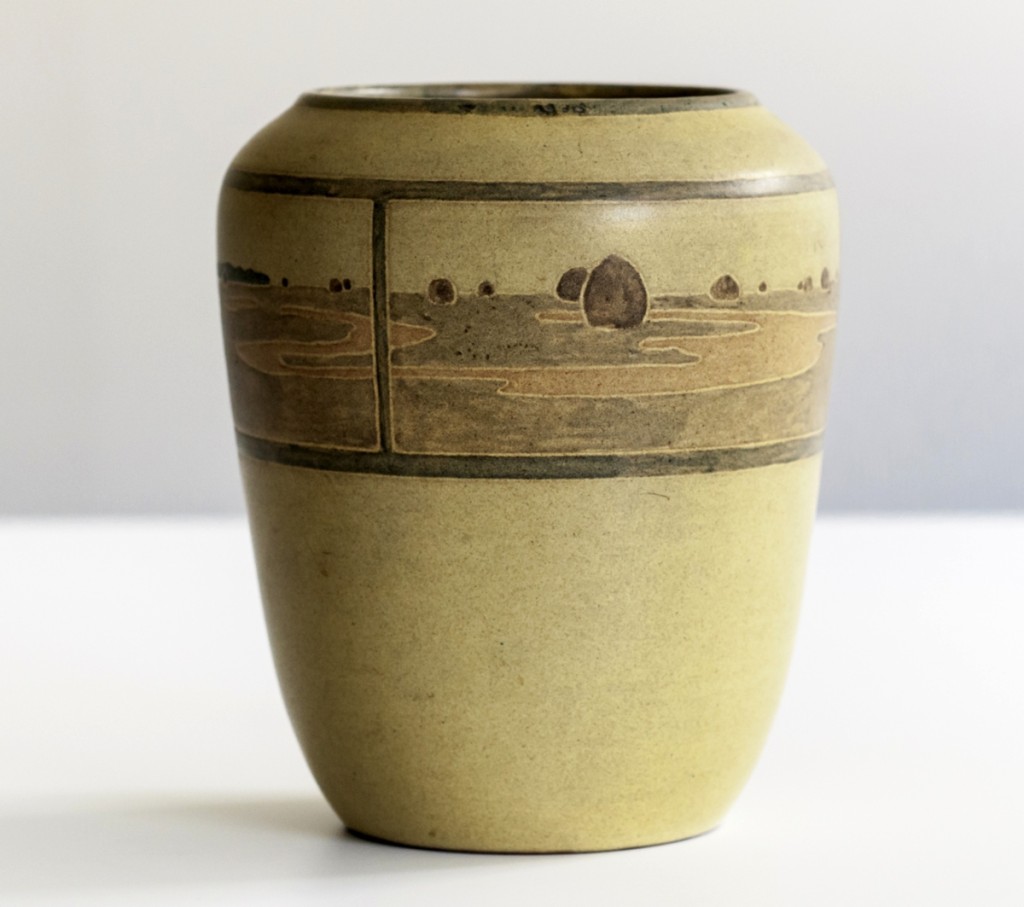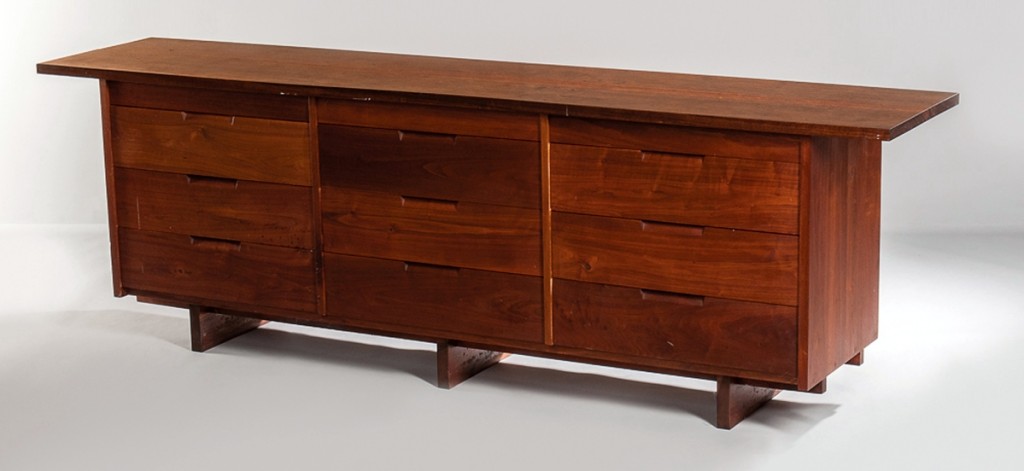
The top selling lot of the sale was this Marblehead Pottery vase, which realized $303,000. One of only four known examples, the landscape vase was designed by Annie E. Aldrich, decorated by Sarah Tutt and made by John Swallow. It was found at a yard sale this past summer by a 19-year-old picker.
Review and Onsite Photos by Rick Russack
BOSTON – It still happens and Skinner’s December 14 Twentieth Century Design sale proved it. A rare piece of Marblehead pottery, found by a 19-year-old picker at a yard sale this past summer, realized $303,000. Skinner, which promoted the work widely, described it as a “Rare Annie E. Aldrich and Sarah Tutt Marblehead Pottery vase, circa 1909. The landscape vase was designed by Annie E. Aldrich, decorated by Sarah Tutt and made by John Swallow. It was marked with an ‘M’ and partial ‘P’ flanking a sailing ship and the letters ‘A’ and ‘T’ beneath the Marblehead mark.” There were three bidders in the room and ten on the phones. The successful bidder, a private collector, was on a phone line. Only four examples of this vase are currently known, one with a hole drilled for a lamp. Only one other is in private hands. That one was sold at a North Shore auction in 2001 for $97,000.
Marilee Boyd Meyer, who established Skinner’s Arts and Crafts department in 1980 and is currently working on a book about Marblehead Pottery, had this to say about this vase, and Marblehead, in general: “There are only four of these marsh landscape pots now known. Interestingly, two are signed with an ‘A’ for Annie Aldrich, a previous patient at the Marblehead Sanatorium for ‘neurasthenic’ patients, of which the pottery was part before it became independent. Its importance also is in the sophisticated decoration depicting the Ipswich marshes, a few towns away from the pottery. Ipswich was also the site for the Ipswich Summer School run by important art educator Arthur Wesley Dow (1857-1922). His seminal 1899 design manual Composition was a staple in libraries, schools and studios well into the 1940s and was most probably in the Marblehead Pottery library.
This vase showcases his promotion and influence of Japanese prints and meandering streams and use of large panels of open space. Marblehead Pottery, made between 1904 and 1936, has been a collector favorite with its smooth matte glazes and abstract designs, especially the early geometric and historically significant pieces like this landscape vase.” A new book about Marblehead Pottery and its founder Arthur Eugene Baggs is currently being researched by Susan J. Montgomery and Meyer and is expected to be published late 2019.
Meyer also commented on the general state of the market: “For a while, some were lamenting the softness of the Arts and Crafts material (actually, they may have been thinking about the depth and response to mid-range production pieces in both furniture and pottery, which has been down). Arts and Crafts has been overshadowed by the midcentury and studio movements lately, yet good Arts and Crafts pieces are still seeing almost shocking numbers. Just a couple of weeks ago, at Sotheby’s a 1901 Gustav Stickley reverse tapered leather top library table brought $275,000.”
This sale, organized roughly chronologically, ran the gamut from Arts and Crafts to Art Deco to Midcentury Modern and included Tiffany lamps and other lighting, Marblehead, Grueby and other art pottery, furniture by well-known names such as Stickley, Juhl and Nakashima, midcentury studio pottery by Lucie Rie, Gerry Williams and others, tableware by Georg Jensen, glass by Galle, Tiffany, Imperial, Lalique and more. There were standouts in each category. Much of the midcentury material came from two exceptional collections put together in the 1970s, at a time when Juhl and Nakashima furniture was new and being used to furnish homes by design-conscious consumers.
This sale included several pieces of Grueby pottery, topped by a 5¼-inch vase with a green glaze, which sold for $2,214. Interestingly, in 1902 William Grueby sued the Merrimac Pottery Company of Newburyport, Mass., to protect his green glaze, insisting that Merrimac was copying it. The suit was unsuccessful as green glazes were used by other potters, but the details make interesting reading per Justin Thomas’s blog, “Early American Ceramics.”

The highest-priced piece of furniture in the sale was this George Nakashima walnut triple chest with 12 drawers, which finished at $27,060.
Clearly, collectors and dealers buying at this sale knew what they wanted and competition was keen for the quality examples, while some lesser examples were unsold. The second highest price of the sale was achieved by a Tiffany Studios floor lamp with a “Maple Leaf” shade, slightly over 22 inches in diameter and signed on both the base and shade, which finished at $67,650. A Tiffany Studios Pomegranate table lamp, with a 16-inch shade, signed on both base and shade, finished at $14,760. A Tiffany Studios Favrile lamp with an unusual green and conical-shaped shade sold to an internet bidder for $9,225. The shade had applied glass jewels and the lamp, signed on both shade and base, reached $9,225. There were other Tiffany Studios table lamps, as well as examples by other makers: a Wilkinson Peony pattern lamp brought $2,214, a Moe-Bridges reverse-painted table lamp went for $1,599, while a J.H. Strobel pottery lamp with a leaded slag glass shade reached $2,583.
Leading the furniture, as one might expect, were pieces by George Nakashima. A walnut triple chest of drawers, with 12 drawers, drew the most interest, finishing at $27,060, more than twice the estimate. A pair of walnut and maple burl “Kornblut” end tables, also brought more than twice the estimate, reaching $25,830. A group of eight walnut spindle-back dining chairs brought $17,220, the same price achieved by a turned leg dining table. The walnut table, with a two-piece top with four rosewood butterfly keys had an unexpected provenance. It came from the Mount Washington Observatory, having been donated to them several years ago when they were furnishing their building.
Finn Juhl furniture did well. A circa 1960 teak table with silver inlays, made for Neils Vodder and branded “Niels Vodder Cabinet Maker Copenhagen Denmark,” finished at $23,370. A pair of Finn Juhl model 45 armchairs, and a model 45 settee, each realized $9,840. There was a great deal of production furniture by Herman Miller and Knoll, and accessories, which sold for modest prices, making this a good time to be starting a collection or simply furnishing a home with well-designed furniture.
Midcentury studio pottery offerings included a conical porcelain bowl by Lucie Rie, one of the more popular studio potters who died in 1995, which sold for $9,840. The bowl had a red and brown glaze over white clay, was marked by the potter and dated to about 1955. An unmarked stoneware bowl by the same potter finished at $6,765.
There were a number of pieces by Edwin and Mary Scheier. An early bowl, with an attractive green glaze and an abstract sgraffito design, reached $2,706. It was bought by Cambridge, Mass., dealer Jim Messineo, JMW Gallery. He said, “It was an early piece, made while the couple was working in New Hampshire, and I’ve always liked their pieces with the abstract designs.” The several pieces of pottery by another New Hampshire potter, Gerry Williams, were topped by a large green bowl with sgraffito designs, which went out at $800, a strong price for the potter’s work. A number of pieces by Massachusetts potter Makoto Yabe were passed.
The sale grossed $1,021,990, with 489 successful bidders, 116 of whom were on the internet. Dan Ayer, Skinner’s Twentieth Century specialist who managed the sale, said, “We were definitely pleased with the sale. The Nakashima did well, the Tiffany did well, and there were strengths in the other categories. We used the internet to promote the sale and we sent out about 1,000 color mailers to folks who have bid in our previous Twentieth Century sales. Our next Twentieth Century sale will be in June, and we expect to feature a selection of New England-made furniture”.
For additional information, www.skinnerinc.com or 508-970-3253.
































